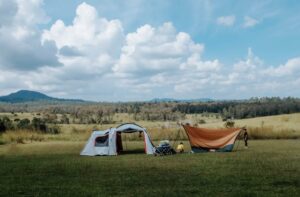
Learn about the incredible achievements of the ancient Egyptians, and immerse ourselves in the rich cultural heritage of this fascinating civilization.
1. The Great Pyramid of Giza:
Our journey begins with the iconic Great Pyramid of Giza, one of the Seven Wonders of the Ancient World. Built around 2580-2560 BCE during the reign of Pharaoh Khufu, this colossal structure stands as a testament to ancient engineering and astronomical knowledge. It served as a tomb for the pharaoh and is the largest and oldest pyramid in the Giza pyramid complex.
2. The Sphinx:
Next, we’ll explore the enigmatic Sphinx, situated near the pyramids in Giza. Carved from a single limestone block and standing at 66 feet (20 meters) high, the Sphinx features the body of a lion and the head of a pharaoh, most likely representing Pharaoh Khafre. Its purpose remains a mystery, adding to its allure.
3. Luxor Temple:
Now, we’ll travel to the east bank of the Nile River to visit the Luxor Temple, dedicated to the Theban triad of Amun, Mut, and Khonsu. This ancient temple complex showcases stunning hieroglyphics, towering statues, and imposing pylons. The temple played a significant role in religious ceremonies and celebrations during the New Kingdom period.

4. Karnak Temple Complex:
Adjacent to Luxor Temple, we’ll find the awe-inspiring Karnak Temple Complex. This vast complex, dedicated to the god Amun-Ra, took over 2,000 years to construct and is a true marvel of ancient Egyptian architecture. Walk among the grand Hypostyle Hall, adorned with towering columns and intricate carvings, and imagine the vibrant festivals and rituals that once took place here.
5. Valley of the Kings and Queens:
Leaving Luxor, we’ll head to the west bank of the Nile to explore the Valley of the Kings and the Valley of the Queens. These rocky tombs house the final resting places of many pharaohs, queens, and nobles. The tomb of Tutankhamun, discovered in 1922 by Howard Carter, is among the most famous in the Valley of the Kings.
6. Abu Simbel Temples:
To the south, we’ll encounter the remarkable Abu Simbel Temples, originally carved into a mountainside during the reign of Pharaoh Ramesses II. The two temples, one dedicated to Ramesses II himself and the other to his wife Queen Nefertari, are renowned for their colossal statues and intricate reliefs.
7. Temple of Horus at Edfu:
Moving northwards along the Nile, we’ll visit the Temple of Horus at Edfu, a remarkably preserved ancient temple dedicated to the falcon-headed god Horus. It offers a glimpse into the religious practices and beliefs of the Ptolemaic period.
8. The Egyptian Museum:
Before concluding our journey, we’ll travel to Cairo to explore the Egyptian Museum. This treasure trove of artifacts houses an extensive collection of ancient Egyptian art, including the golden mask of Tutankhamun and countless other fascinating relics.
Our Journey Through Time has only scratched the surface of Egypt’s ancient wonders. This civilization’s contributions to architecture, art, science, and culture continue to captivate and inspire people from around the world. As we end our adventure, may the spirit of discovery and appreciation for Egypt’s ancient wonders stay with you always. Safe travels!
Related Posts
The Wonders of Thermal Water: Advantages for Your SkinThermal water, a natural gift from deep within the Earth, has been cherished for centuries for its numerous benefits for the skin. Emerging from underground sources and enriched with minerals and trace elements, thermal water offers a plethora of advantages that can transform your skincare routine. In this article, we'll explore the wonders of thermal water and its advantages for your skin. 1. Soothing and Calming Properties: Thermal water is renowned for its soothing and calming properties. When sprayed or applied to the skin, it helps reduce skin irritation, redness, and inflammation caused by various factors such as pollution, sun exposure, or harsh skincare products. It provides instant relief to sensitive and reactive skin, making it a go-to remedy for those seeking comfort and balance. 2. Hydration and Moisture Retention: One of the primary advantages of thermal water is its exceptional hydration abilities. Packed with essential minerals like calcium, magnesium,…
Embracing a Wholesome Culinary Journey: Exploring the Benefits of Healthy CookingIn a world where convenience often takes precedence over nutrition, adopting a healthy style of cooking has become a powerful way to nourish our bodies and enhance overall well-being. Healthy cooking is not just about following fad diets or restricting ourselves; it's a holistic approach to preparing and enjoying food that promotes good health without sacrificing flavor and satisfaction. In this article, we'll delve into the art of healthy cooking, the benefits it offers, and practical tips to make it a rewarding and sustainable part of our culinary journey. Understanding Healthy Cooking: Healthy cooking is about embracing fresh, whole, and nutrient-rich ingredients while minimizing processed and unhealthy elements. It involves mindful choices in selecting ingredients, cooking methods, and portion sizes to ensure that the meals we prepare nourish our bodies and support a balanced lifestyle. By focusing on whole foods and incorporating a variety of fruits, vegetables, lean proteins, whole…
Favorite travel destinations in Scandinavia1. Copenhagen, Denmark - known for its stunning architecture, colorful houses, and iconic biking culture. 2. Oslo, Norway - a perfect blend of modern architecture and natural beauty, featuring fjords, glaciers, and mountains. 3. Stockholm, Sweden - known as the "Venice of the North", it is made up of 14 islands connected by bridges, featuring historic landmarks and a vibrant nightlife. 4. Reykjavik, Iceland - offering unique experiences such as the Northern Lights and the Blue Lagoon, as well as stunning landscapes. 5. Helsinki, Finland - the capital city offers a mix of modern and traditional Finnish culture, with museums, art galleries, and stunning architecture. 6. Bergen, Norway - known as the gateway to the fjords, it offers amazing views of the surrounding nature. 7. Lapland, Finland - a winter wonderland where you can experience the midnight sun, husky rides, skiing, and meet Santa Claus.
How to become a travel agent and work from home1. Get the necessary education or training: A high school diploma or equivalent is required to become a travel agent. But, getting a degree or certification in travel and tourism can give you an advantage. 2. Gain work experience: It is important to have experience in the travel industry. You can start by working for a travel agency or any other travel-related business. 3. Get a license: Some states require travel agents to have a license before they can operate. Check with your state's licensing requirements and get the necessary license. 4. Join a professional association: Joining a professional association, such as the American Society of Travel Agents (ASTA), can help you network with other travel agents and gain access to industry news and resources. 5. Set up your home office: In order to work from home, you need to have a dedicated workspace with the necessary equipment and internet…
Steady Internet Access During Your TravelIn the digital age, the internet has revolutionized the way we travel. Gone are the days of relying solely on guidebooks and physical maps; today, travelers have access to an abundance of information and resources at their fingertips. The convenience of using the internet during travel cannot be denied, but it also comes with its unique set of challenges that adventurers must navigate. This article explores the benefits of using the internet while traveling and discusses some of the common challenges faced by modern globetrotters. 1. The Advantages of Using the Internet During Travel a. Seamless Trip Planning: The internet offers a vast array of resources to assist travelers in planning their journeys. From booking flights and accommodations to researching local attractions and activities, the internet streamlines the process and allows for greater flexibility. b. Real-time Navigation: GPS and mapping apps have revolutionized navigation. Travelers can easily find their way…
The Ultimate Travel Checklist: What to Pack for Your AdventurePreparing for a travel adventure can be exciting, but it's essential to have a well-thought-out packing checklist to ensure you have everything you need for a smooth and enjoyable journey. Here's the ultimate travel checklist to help you pack for your adventure: 1. Travel Documents: - Passport/ID - Visa (if required) - Travel insurance information - Flight/train tickets - Itinerary and hotel reservations - Driver's license (if needed) - Any necessary vaccination certificates 2. Money and Essentials: - Sufficient cash in the local currency - Credit/debit cards - Travel wallet or money belt - Emergency contact information and important phone numbers - Health insurance cards 3. Technology and Entertainment: - Smartphone and charger - Travel adapter and converter (if needed) - Camera and extra memory cards - Portable power bank - E-reader or physical books - Headphones/earbuds 4. Personal Care Items: - Prescription medications and copies of prescriptions - Personal…
Unveiling Hidden Gems: Less-Known Summer Destinations for Travel EnthusiastsWhen summer arrives, wanderlust sets in, and travelers begin to seek out the perfect vacation spot. While popular destinations often steal the spotlight, there are countless hidden gems waiting to be discovered by those seeking unique and off-the-beaten-path experiences. In this article, we will unveil some lesser-known summer destinations that promise breathtaking landscapes, rich cultures, and unforgettable adventures. 1. Faroe Islands, Denmark: Tucked away in the North Atlantic Ocean, the Faroe Islands boast dramatic cliffs, lush green valleys, and picturesque fishing villages. Nature lovers will be captivated by the untouched beauty and diverse wildlife of this remote archipelago. 2. Svalbard, Norway: For intrepid adventurers, Svalbard is an Arctic paradise. This Norwegian archipelago offers stunning glaciers, polar bears, and the mesmerizing midnight sun during summer. 3. Puglia, Italy: Located in the southern region of Italy, Puglia is a hidden gem known for its whitewashed towns, olive groves, and stunning coastline with…
Unraveling the Unexpected Fees in TravelPlanning a trip can be both exciting and overwhelming, with countless details to consider. From booking flights and accommodation to mapping out an itinerary, travelers often devote their time to crafting the perfect vacation experience. However, amid the enthusiasm, there exists a lurking menace that can quickly turn travel dreams into a financial nightmare: unexpected fees. Unforeseen charges can crop up at various stages of the travel journey, leaving travelers feeling perplexed and cheated. In this article, we explore some of the most common unexpected fees in travel and offer tips on how to avoid falling prey to them. 1. Baggage Fees Airlines have become notorious for hidden baggage fees, catching many travelers off-guard. After securing what seems like a great flight deal, they discover that checking a bag comes with a hefty additional cost. To avoid this unpleasant surprise, travelers should thoroughly research an airline's baggage policy before booking.…
20 tips on how to learn a new language in a month1. Set a clear goal and a deadline for learning. 2. Create a daily schedule for studying. 3. Start with the most common words and phrases. 4. Learn basic grammar rules. 5. Practice speaking every day, even if it's just to yourself. 6. Listen to music and watch TV shows in the language you're learning. 7. Use language learning apps like Duolingo and Babbel. 8. Immerse yourself in the language by surrounding yourself with native speakers or listening to podcasts. 9. Use flashcards or other memorization techniques to learn new vocabulary words. 10. Make mistakes and learn from them. 11. Join language exchange groups online or in-person. 12. Keep a notebook to write down new words and concepts. 13. Focus on communication rather than perfection. 14. Practice with a language tutor or coach. 15. Try to think in the language you're learning. 16. Stay motivated by setting mini-goals and celebrating…
Tips for outdoor adventure in winterWhen it comes to outdoor adventures in winter, there are some necessary precautions that must be taken before embarking on any expedition. The winter season brings with it numerous risks that must be mitigated to ensure a safe and enjoyable experience. Here are some tips and guidelines to follow to make the most out of your winter outdoor adventures. 1. Dress appropriately - Before setting out on any winter adventure, it is vital to dress appropriately to protect yourself from the cold. Wearing layers, including insulated jackets, pants, and thick socks, can keep you warm and comfortable throughout your expedition. Additionally, wearing waterproof boots, gloves, and a hat can protect your extremities and prevent frostbite. 2. Be prepared - Winter weather can be unpredictable, and it is essential to be prepared for unexpected storms or cold snaps. Ensure that you bring the necessary survival gear, including extra food, water, and…



